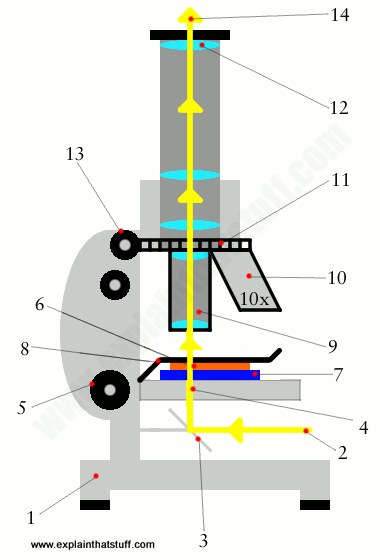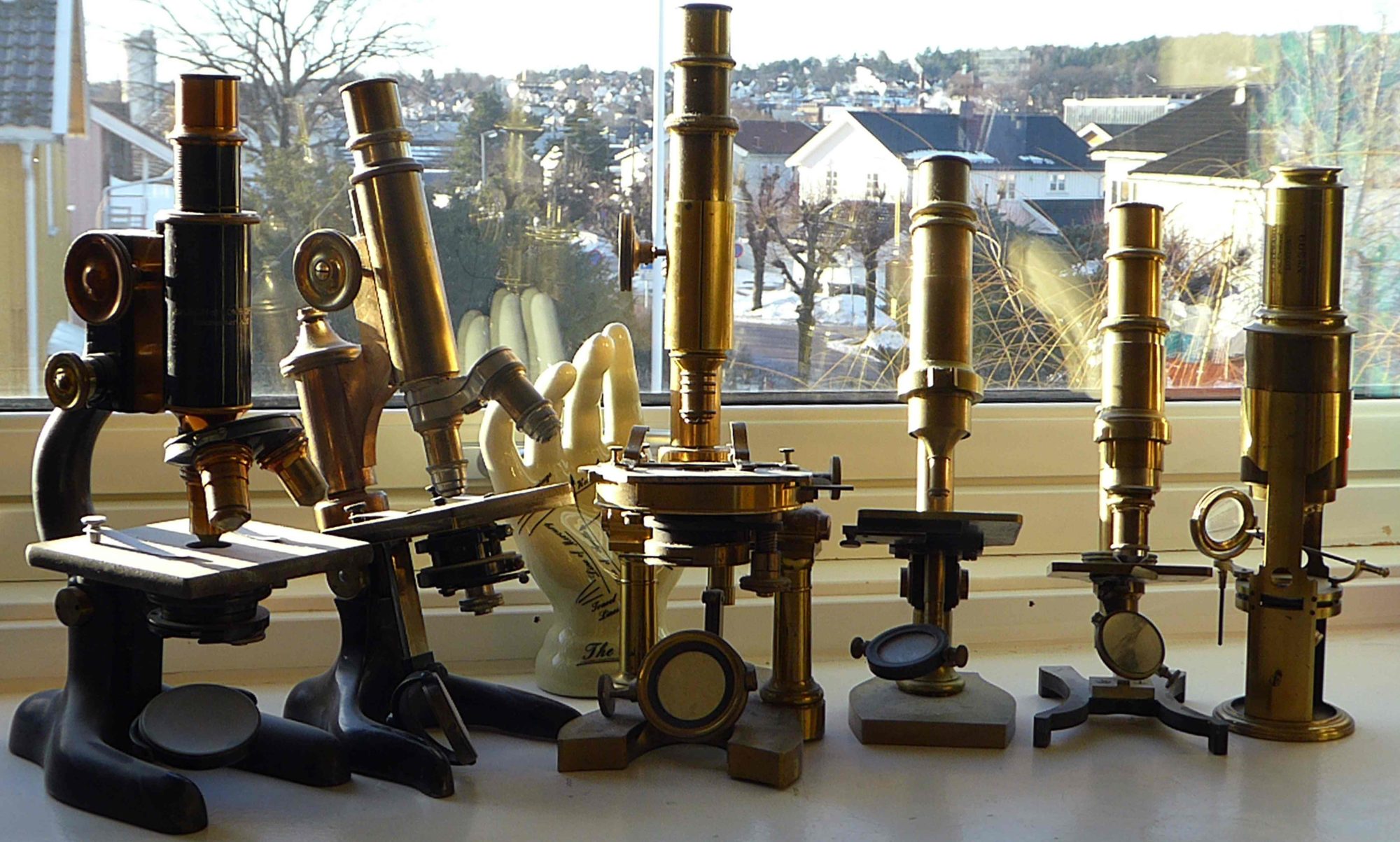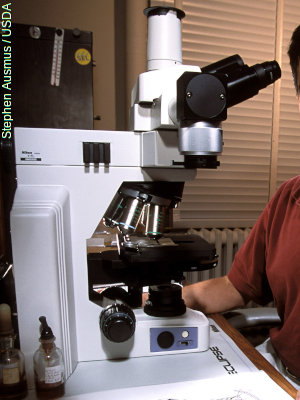How microscopes work
The plant on your windowsill is buzzing with life, turning sunlight into sugar all day long. Mold is slowly gobbling up the apples in your fruit bowl. Your bed is creeping with dust mites. The air is packed with pollen…
It’s a truly amazing thought: there are zillions of things happening all around us, all the time, that are far too tiny for our eyes to see! But never fear, because we have an equally amazing way to get around it. Powerful microscopes shed new light on the teeny tiny and make the invisible, visible. They’ve played an enormous part in science by taking us deep into worlds we’ve come to think of as “microscopic.” Just as telescopes scale us up to meet the planets and stars, so microscopes scale us down into the tiny world of atoms and cells. Let’s take a closer look at how they work!
Photo: A typical optical microscope. Photo by Stephen Ausmus courtesy of US Department of Agriculture: Agricultural Research Service (USDA-ARS).
Contents
Why do we need microscopes?

Photo: A scientist studies leaves for traces of ticks. Photo by Scott Bauer courtesy of US Department of Agriculture: Agricultural Research Service (USDA-ARS).
Lots of things are invisible, but that doesn’t mean they’re not there. Radio and TV broadcasts are constantly whistling through your head from powerful transmitters, but unless you happen to have a cunning piece of electronic equipment at your disposal—namely a radio or TV set—you won’t be able to understand them. We’re used to the world being the totality of things we can see; that there are worlds out there our eyes aren’t tuned into is both a physical problem and a philosophical conundrum.
Imagine if your eyes were as powerful as microscopes and you could see all the germs crawling about on your hands. Your brain would be so busy boggling that you wouldn’t be able to concentrate on bigger things at a more meaningful scale. Through millions of years of evolution, our eyes and brains are programmed to worry about the things that matter most—things on a similar scale to our bodies. We simply don’t have the time or the brain capacity to worry about absolutely everything that’s going on. If you were constantly staring at the bugs on your fingers, you could easily get so distracted that you’d walk straight under a bus! Don’t understand? Let’s put it this way. The smaller the things you look at, the more there is to see, the more information there is to process, and the longer it takes. If you could see microscopically all day long, you’d have to react much more slowly to the world around you—and that extra reaction time would threaten your life.
This, then, is what invisible means: our bodies are finely tuned to the business of day-to-day living on a human scale and efficiently designed to ignore everything else.
Once upon a time, we used to ignore things we couldn’t see. But thanks to modern science, we know there’s a whole lot happening on the microscopic scale that can help us to live our lives more effectively. Scientists have known since the 17th century that the insides of living things are made up of tiny functioning factories called cells; understanding how they work helps us to tackle sickness and disease. More recently, during the 20th century, scientists figured out how materials are made of atoms and how atoms themselves are built from smaller “subatomic” particles; understanding atomic structure paved the way for all kinds of amazing inventions, from electronic transistors to nuclear power.
How microscopes work

Photo: Most microscopes have several different objective lenses that turn around on a thumb-wheel to give different levels of magnification. Going from right to left, the lenses you can see here magnify by twenty times (20x), forty times (40x), and a hundred times (100x). Photo by Stephen Ausmus courtesy of US Department of Agriculture: Agricultural Research Service (USDA-ARS).
Microscopes are effectively just tubes packed with lenses, curved pieces of glass that bend (or refract) light rays passing through them. The simplest microscope of all is a magnifying glass made from a single convex lens, which typically magnifies by about 5–10 times. Microscopes used in homes, schools, and professional laboratories are actually compound microscopes and use at least two lenses to produce a magnified image. There’s a lens above the object (called the objective lens) and another lens near your eye (called the eyepiece or ocular lens). Each of these may, in fact, be made up of a series of different lenses. Most compound microscopes can magnify by 10, 20, 40, or 100 times, though professional ones can magnify by 1000 times or more. For greater magnification than this, scientists generally use electron microscopes.
So what does a microscope actually do? Imagine a fly sitting on the table in front of you. The big, fat, compound eye on the front of its head is just a few millimeters across, but it’s made up of around 6000 tiny segments, each one a tiny, functioning eye in miniature. To see a fly’s eye in detail, our own eyes would need to be able to process details that are millimeters divided into thousands—millionths of a meter (or microns, as they’re usually called). Your eyes may be good, but they’re not that good. To study a fly’s eye really well, you’d need it to be maybe 10–100 cm (4–40 in) across: the sort of size it would be in a nice big photo. That’s the job a microscope does. Using very precisely made glass lenses, it takes the minutely separated light rays coming from something tiny (like a fly’s eye) and spreads them apart so they appear to be coming from a much bigger object.
Parts of a microscope
A compound microscope uses two or more lenses to produce a magnified image of an object, known as a specimen, placed on a slide (a piece of glass) at the base.

- The microscope rests securely on a stand on a table.
- Daylight from the room (or from a bright lamp) shines in at the bottom.
- The light rays hit an angled mirror and change direction, traveling straight up toward the specimen. The mirror pivots. You can adjust it to capture more light and alter the brightness of the image you see.
- The light rays pass through a hole in an adjustable horizontal platform called the stage.
- The stage moves up and down when you turn a thumb wheel on the side of the microscope. By raising and lowering the stage, you move the lenses closer to or further away from the object you’re examining, adjusting the focus of the image you see.
- To look at something under a microscope (such as a plant leaf), you prepare a specimen of it. The specimen has to be a very thin slice so light rays will pass through.
- You mount the specimen on a glass slide with a glass cover slip on top to keep it in place.
- The slide is held in place by two metal clips, one on either side.
- Light traveling up from the mirror passes through the glass slide, specimen, and cover slip to the objective lens (the one closest to the object). This makes the first magnification: it works by spreading out light rays from the specimen so they appear to come from a bigger object. The objective “lens” usually consists of more than one lens.
- A selection of other objective lenses can be used to magnify the specimen by more or less.
- The thumb wheel makes it easy to swing the other lenses into position.
- The eyepiece lens (the one closest to your eye) magnifies the image from the objective lens, rather like a magnifying glass.
- On some microscopes, you can move the eyepiece up and down by turning a wheel. This gives you fine control or “fine tuning” of the focus.
- You look down on a magnified image of the object.

Artwork: A classic optical microscope from the late 19th century. From US Patent 328,277: Microscope by Edward Bausch, granted October, 13, 1885, courtesy of US Patent and Trademark Office.
That’s the theory; here’s what it looks like in practice. This is a diagram of a classic Bausch microscope from 1885, and you can see straight away that little has changed over the last century or so. I’ve colored the main parts and simplified the numbering to make it easier to understand. Briefly, we have:
- A heavy metal base gives the microscope a low center of gravity so it’s less likely to tip over. The rest of the microscope is made of lightweight sheet metal to keep the cost and weight down.
- A hinge allows the main optical tube to pivot up and down.
- The focusing mechanism on this scope uses a rack and pinion gear to bring the lenses nearer to or further from the object you’re viewing.
- The eyepiece (orange) and eyepiece lens (yellow).
- A field lens (yellow) ensures more of the light from the object goes into the eyepiece.
- The main imaging tube is made from spun or stamped sheet metal.
- The objective lens.
- The stage and glass slide.
- The sub-stage includes an iris (diaphragm) to regulate the amount of light passing through.
- One or more mirrors for catching and reflecting light up through the slide.
Polarizing microscopes

Photo: An antique Nachet polarizing microscope, based on a design invented in 1833. This one, dating from 1880, uses two light-polarizing (Nicol) prisms, one underneath the stage and the other in the eyepiece. Photo courtesy of National Institute of Standards and Technology Digital Collections, Gaithersburg, MD 20899.
As we’ve just seen, a basic optical microscope uses one or more lenses to bend the light bouncing off (or traveling through) a specimen, so fooling our brains into thinking what we’re looking at is bigger than it really is. But there are other kinds of optical microscopes that work in different ways.
Ordinary light consists of waves that vibrate in every direction. If we pass light like this through a grid-like filter, so the waves can vibrate in only one direction (plane), what we get is called polarized light (or, sometimes, plane-polarized light). If you shine polarized light through an ordinary piece of glass, it bends in the usual way through the process of refraction (or refringence, as it was once known). We can compare the amount by which light bends in different materials using a measurement called the refractive index. (Refraction is explained in more detail in our main article about light.)
So far so good. But other solid materials, including ice, calcium carbonate, quartz, plastics (such as cellophane), stressed plastics, and various other crystals, change light in different ways when it travels through them in different directions. If you pass light through these materials, something much more interesting happens: it splits into two separate waves that bend by different amounts. In other words, unlike glass (which has a single refractive index), these materials have two refractive indices; that’s why this effect is called birefringence (in effect, double refraction). If you collect the two waves coming out of a birefringent crystal and pass them through another polarizing filter, called an analyzer, which is set up at right angles to the first polarizing filter, they recombine, interfere with one another, and produce colorful patterns that change as you rotate the specimen.

Photo: Photoleasticity means using polarized light to study the stress patterns in a material. In this example, I’m making some polarized light using an ordinary LCD laptop screen, passing it through a plastic CD case, and viewing the result through polarizing sunglasses. Polarizing microscopes work in a broadly similar way.
Polarizing microscopes are based on this idea: they’re much like ordinary optical microscopes but with polarizing filters fitted above and below the specimen. We can use them to study birefringence and other properties of materials, which can help us identify minerals or figure out important things about their inner structure. Polarizing microscopes have useful applications in:
- Geology—for example, studying the mineral components of a particular rock.
- Crystallography—for identifying crystals in everything from forensic science to art conservation.
- Materials science—such as studying the stress on certain mechanical components using photoelasticity.
- Medicine—including urinalysis (diagnosing medical problems from the substances in someone’s urine).
Electron microscopes

Photo: Ordinary microscopes are “powered” by light. When light shines on the specimen at the bottom, it travels straight through or reflects off the surface, passing up through the lenses into the eyepiece. Microscopes that use light are called optical microscopes to distinguish them from electron microscopes, which use electrons for seeing instead of light. Photo by Peggy Greb courtesy of US Department of Agriculture: Agricultural Research Service (USDA-ARS).
Even the best microscopes have their limits: most can’t magnify more than a few thousand times. Why? One way of understanding light is to say that it’s made up of energetic particles called photons, which behave like waves hundreds of times thinner than a human hair. But what if we want to look at things smaller than this? In that case, we can’t use light: we have to use particles with even smaller wavelengths—namely electrons, the tiny negatively charged particles that whizz around inside atoms. Microscopes that work in this way are called electron microscopes.





 Views Today : 141
Views Today : 141
